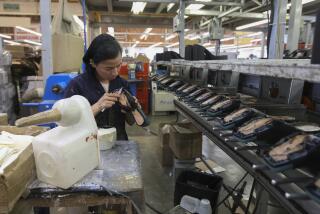Trade Gap, Though Wider, Is Better Than Anticipated : At $10.9 Billion, May Deficit Is Second Smallest in 3 Years, Raising Hopes 1988 Total Will Be $30 Billion Less Than ’87
- Share via
WASHINGTON — Demonstrating that earlier declines in the trade deficit were not flukes, the United States chalked up a better-than-expected trade imbalance of $10.9 billion in May, the Commerce Department reported Friday.
It was the second-narrowest monthly trade gap in almost three years, just slightly higher than the revised $10.3 billion deficit in April, and it left the nation in a position to slash its trade deficit in 1988 by at least $30 billion from last year’s total. A decline this year would mark the first annual drop in eight years.
“The trade numbers continue to show a big improvement,” said David Hale, chief economist at Kemper Financial Services in Chicago. After last year’s record trade deficit of more than $170 billion, “we’re now in line to get the deficit under $140 billion,” he added.
Analysts also cautioned that the decline of the monthly trade imbalance from its peak of $15.6 billion last October has been so rapid over the past few months that such gains are unlikely to continue at the same pace.
Narrowing Should Continue
“I expect to see only very modest further improvements for the rest of this year,” said John Hekman, a trade specialist at Claremont Economics Institute in Southern California. “We’ve had such a big change already this year that it is probably wishful thinking to count on much more of the same.”
Already, Hekman noted, the deficit is running at a monthly rate that would produce a gap this year between exports and imports of as little as $125 billion. “And, over the longer run, the trade gap should continue to narrow,” he added, “as the United States very significantly increases its productive capacity.”
The trade deficit with Japan, larger than that with any other trading partner, fell modestly to $4.1 billion from $4.4 billion during April, primarily because of a dropoff in imported automobiles and other goods from Japan.
The U.S. dollar, propelled up by the positive news on the trade front, rose to its highest levels in a year Friday against several major foreign currencies. The gains came despite modest efforts by the West German Bundesbank, the Bank of England and the U.S. Federal Reserve to stem the dollar’s rise by selling dollars on international currency markets.
Pressure Still Downward
Analysts said they expected speculators to continue to push the dollar higher because central banks would be reluctant to intervene heavily enough to risk a sharp drop in the U.S. currency in the critical months leading up to the presidential election.
But analysts also expect the dollar to eventually resume its downward trend of the past three years on the theory that a lower dollar, which forces up the cost of foreign goods in the United States and makes U.S. goods cheaper abroad, is a critical element in bringing down the U.S. trade deficit.
“The dollar will probably look pretty good for a while, but the underlying pressure still has to be in a downward direction,” said C. Fred Bergsten, director of the Institute for International Economics here.
“Right now,” Bergsten said, “our higher interest rates are attracting a lot of hot capital (from foreign investors), and currency traders are confident they can make money betting on the upside because they recognize that (economic) officials have agreed not to let the dollar plunge.”
The Reagan Administration, which has been under assault on Capitol Hill the past several years for allowing the trade deficit to soar, was particularly pleased by the latest numbers.
“The worst of the trade deficit is over,” U.S. Trade Representative Clayton Yeutter said.
U.S. exports, despite a sharp drop in gold shipments as Taiwan reduced its massive purchases, increased by 2.3% to a seasonally adjusted $26.6 billion in May.
Imports, meanwhile, rebounded by 3.4% after two months of decline. But most of the increase was due to a sharp jump in the nation’s imported oil bill of $600 million.
For the first five months of the year, U.S. exports exploded by 31% over the same period a year earlier as American producers found growing demand abroad for their goods, particularly the specialized industrial products the nation has long excelled at making.
Imports Up 11%
Imports rose by 11% over the same period. Economists were encouraged that the biggest gains were in capital goods and industrial materials used in expanding production, rather than in consumer goods.
“The trade numbers are great,” said Joe Carson, an economist with Chemical Bank in New York. “They show that domestic manufacturers continue to gain market share overseas and at home.”
The U.S. trade deficit with South Korea, Taiwan, Hong Kong and Singapore, whose economies depend on exports, grew to $2.3 billion, from $1.6 billion the previous month. But most of that increase was the result of Taiwan’s slowdown in gold purchases rather than any fundamental change in trade patterns.
The trade gap also widened to $1.2 billion with Western Europe from roughly $800 million the previous month. Despite the deterioration, the U.S. deficit has been cut nearly in half so far this year in comparison with the same period in 1987 because of the sharp increase in exports to the improving economies in Europe.
More to Read
Inside the business of entertainment
The Wide Shot brings you news, analysis and insights on everything from streaming wars to production — and what it all means for the future.
You may occasionally receive promotional content from the Los Angeles Times.










